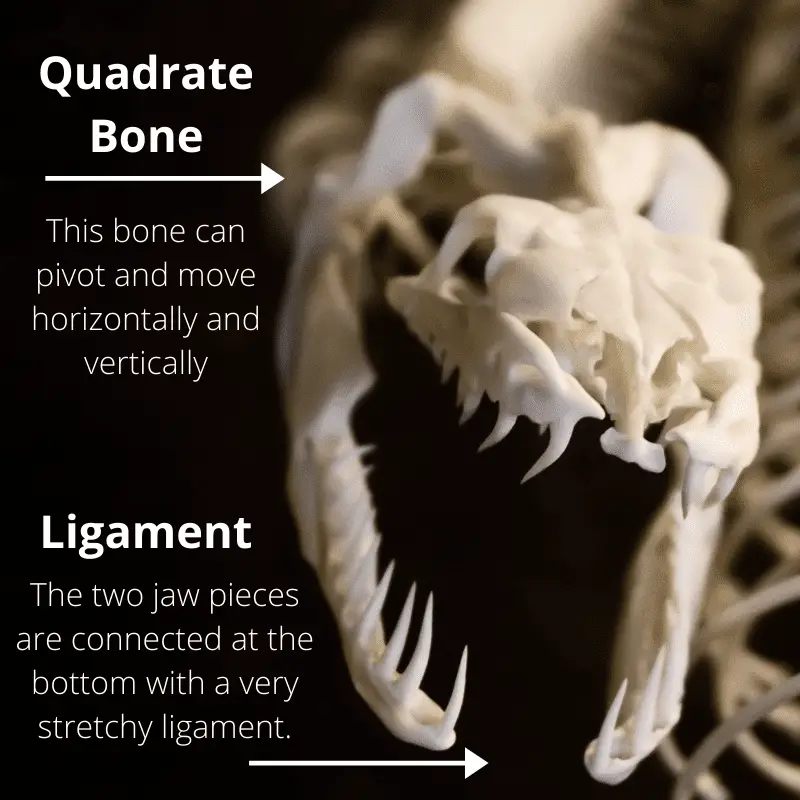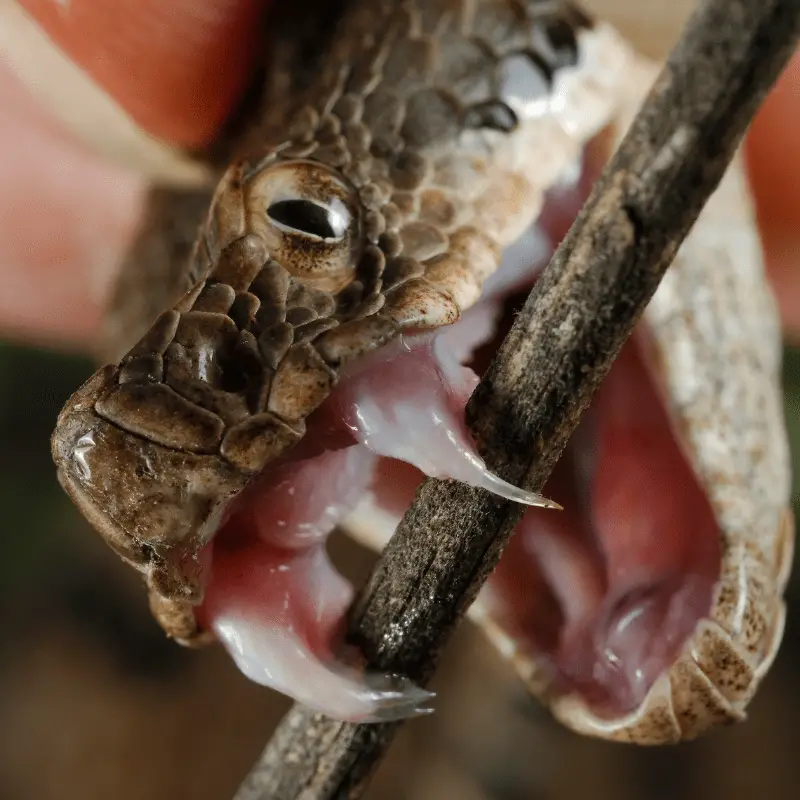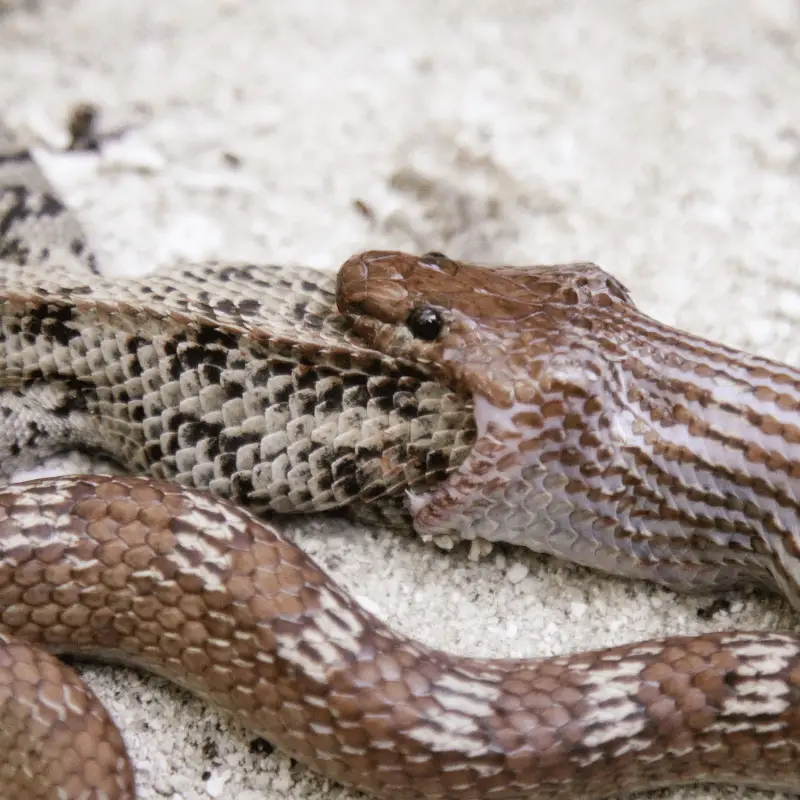The jaw anatomy of a snake is genuinely fascinating and is entirely different to most animals and humans.
The anatomy of the snake’s jaw allows them to swallow large prey. The side quadrate bones are loosely hinged that can pivot horizontally and vertically. In addition, the bottom jaw is attached by an elastic ligament, which can stretch to a considerable size allowing a snake to swallow large prey.
Snakes Jaw Anatomy

The arrangement and the number of teeth depend on the type of species of snake. Some snakes won’t have many teeth, while some have several teeth.
The teeth play an essential role in aiding the swallowing of prey. The teeth alinement draws food into the mouth rather than the need to chew first then swallow.
Did you know that snakes can re-grow their teeth if they ever lose them, including those that have fangs?
The majority of snakes have six rows of teeth, one row on each side of the lower jaw, as well as two rows on each upper jaw.
Teeth Types
Snakes do not have conventional molars, premolars or incisors. Instead, snakes are put into four types of different teeth, depending on the snake species.
- Aglyphous
- Opsthoglyphous
- Proteroglyphous
- Solenoglyphous
Aglyphous
Aglyphous snakes have grooveless teeth and all of a similar size. These snakes are non-venomous that have these types of teeth.
Opsthoglyphous
Opsthoglyphous snakes have large teeth in the back of the jaw that angle backwards and are grooved to channel venom into the puncture.
Proteroglyphous
Proteroglyphous snakes have forward short hollow grooved fangs. In addition, they have fixed fangs in the front of the jaw with grooves or channels to release the venom.
Solenoglyphous
Solenglyphouse type of snakes, the fangs fold up against the roof of the mouth. They are hollow and inject venom deep into the prey.
Fangs

Depending on the type of snake, they may have fangs or not. Some will have fangs located at the front and some at the rear of the mouth. All snakes that have fangs are venomous. Snakes such as the vipers their fangs “solenoglyphous” will fold back against the roof of the mouth when not in use. They are also covered by a membrane called a sheath.
In elapids, snakes like the Black Mamba have short fangs “Proteroglyphous” fixed in the front of the upper jaw, which they remain erect and do not fold.
Digestive System
Oral cavity
A snake’s mouth can open widely by the jaws’ independent movement and does not lock at a specific stretched size. Instead, a ligament connects the jaw of a snake to extend and consume large prey.
Mucous Salivary Gland
These glands moisten the mouth to digest and lubricate the prey it consumes. In addition, the venom glands produce toxins that kill the prey when inside the oral cavity of a snake.
Tongue
The tongue lies directly on the floor of the mouth central to the glottis. It’s wired directly into the Jacobson’s organ and plays no part in aiding the prey’s swallowing. During the shedding process, a snake will also shed its tongue. The snake’s oral mucosa membrane is paler than other creatures due to the lesser amount of red blood cells.
Oesophagus
The oesophagus of a snake is capable of being distended or stretched, depending on the prey size. It has thin muscles. The oesophagus passes through the vascular created by the left and right aortae. The oesophagus runs lengthways with folds that are covered with cells called the ciliated columnar epithelium. When at the cardiac sphincter, the oesophagus ends.
Stomach
The stomach of a snake can stretch and de stretch depending on the size of prey. This is because the stomach has thick walls and a circular cross-section and tapering towards each end.
Intestines
The small intestine
The small intestine is relatively uncoiled but has several short transverse loops tightly enveloped by the dorsal mesentery. It empties into the colon that stores faeces.
The large intestine
A snake’s large intestine is relatively broad and is separated from the cloaca by a recognizable fold.
How does the prey move down the body of a snake?
The jaw moves independently of each other, slowly inching the prey into the throat. Simultaneously, the snake’s head walks forward in a side-to-side motion over the prey’s body, so as the prey is levered backwards, the head moves forward, thus pushing down the prey.
Snakes don’t chew their food; they chemically digest it.
You could say the snakes move up the prey, resulting in the prey going further and further inside the body.
Can a snake die from eating something too big?
Snakes are very good at knowing what size prey they can fit into their mouths. Although rare occasions, it’s not unheard of that a snake has died from eating something too large. However, most of the time, a snake will spit the food back out if it’s too large to go down.
Why do snakes eat things whole?
Snakes don’t have the proper teeth to chew their food, such as conventional molars, premolars or incisors. Their teeth are designed to aid in the pushing down of the prey rather than chewing then swallowing. The jaw also supports the eating prey whole by stretching in size to allow the large prey to travel down with ease—the chemicals in the body then complete the rest and digest the prey.
Did you know that the warmer a snakes body is, the faster they digest their food?
Can a snake break its jaw?
All bones can break; however, the bones of a snake can move independently of each other, which gives the bones a lot of natural movement on impact, resulting in fewer breakage points. During hunting, the bottom jaw can often get caught on the upper teeth if they strike prey and miss the target.


